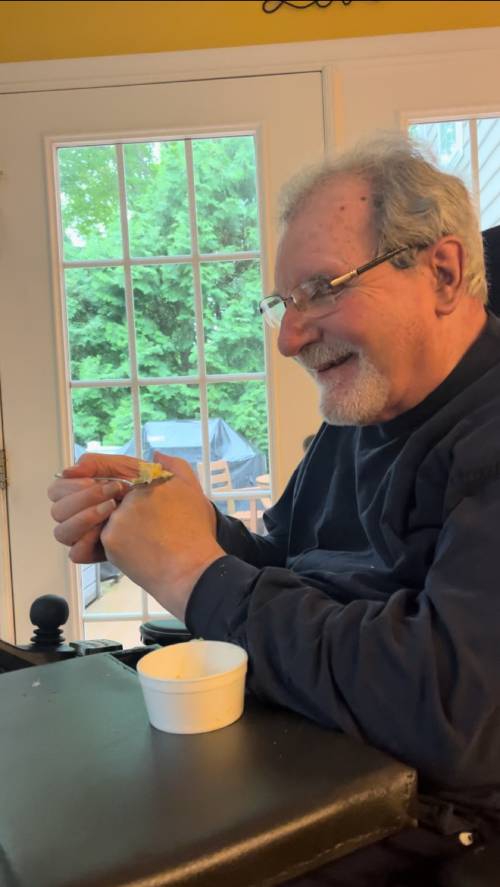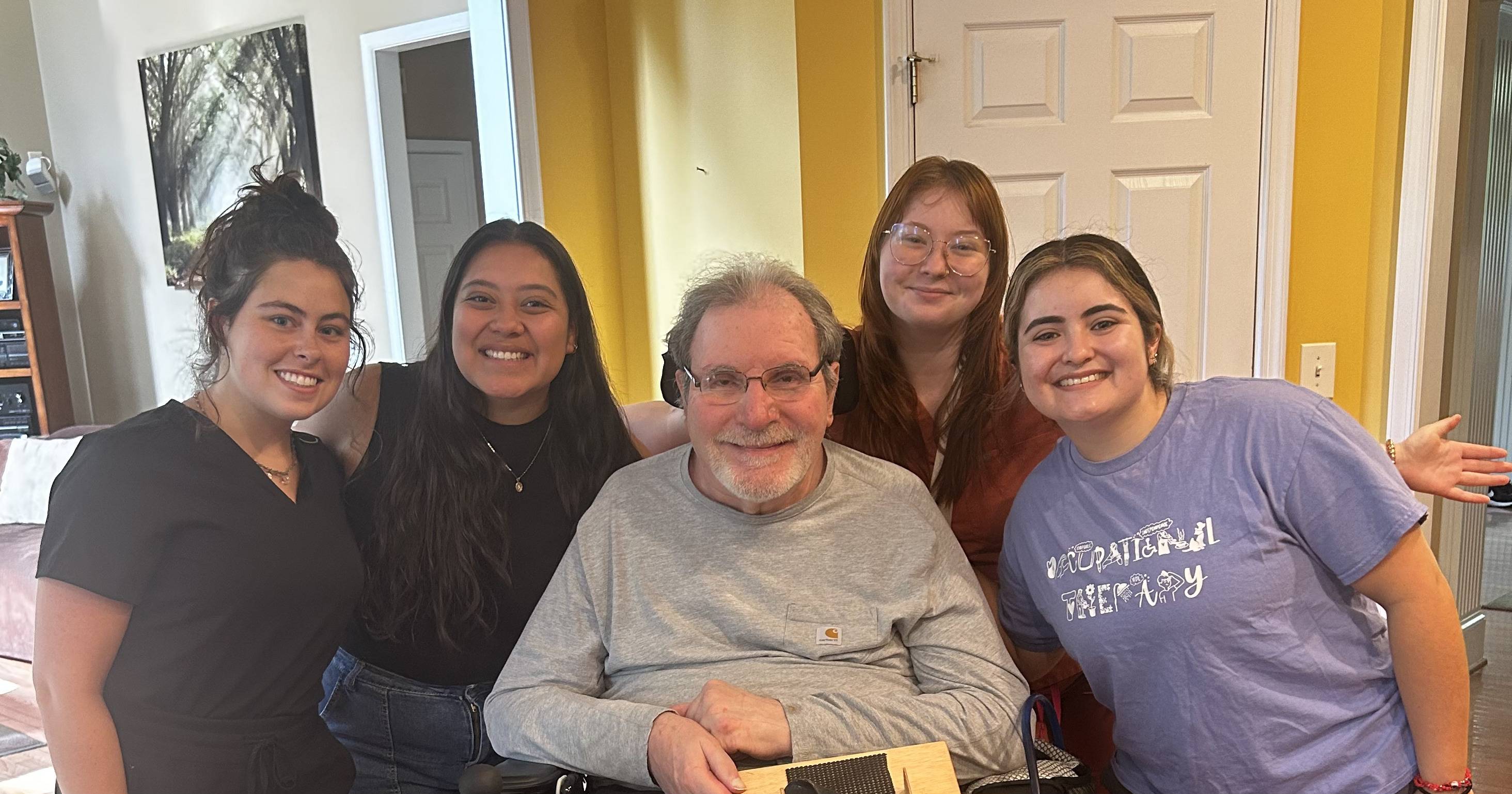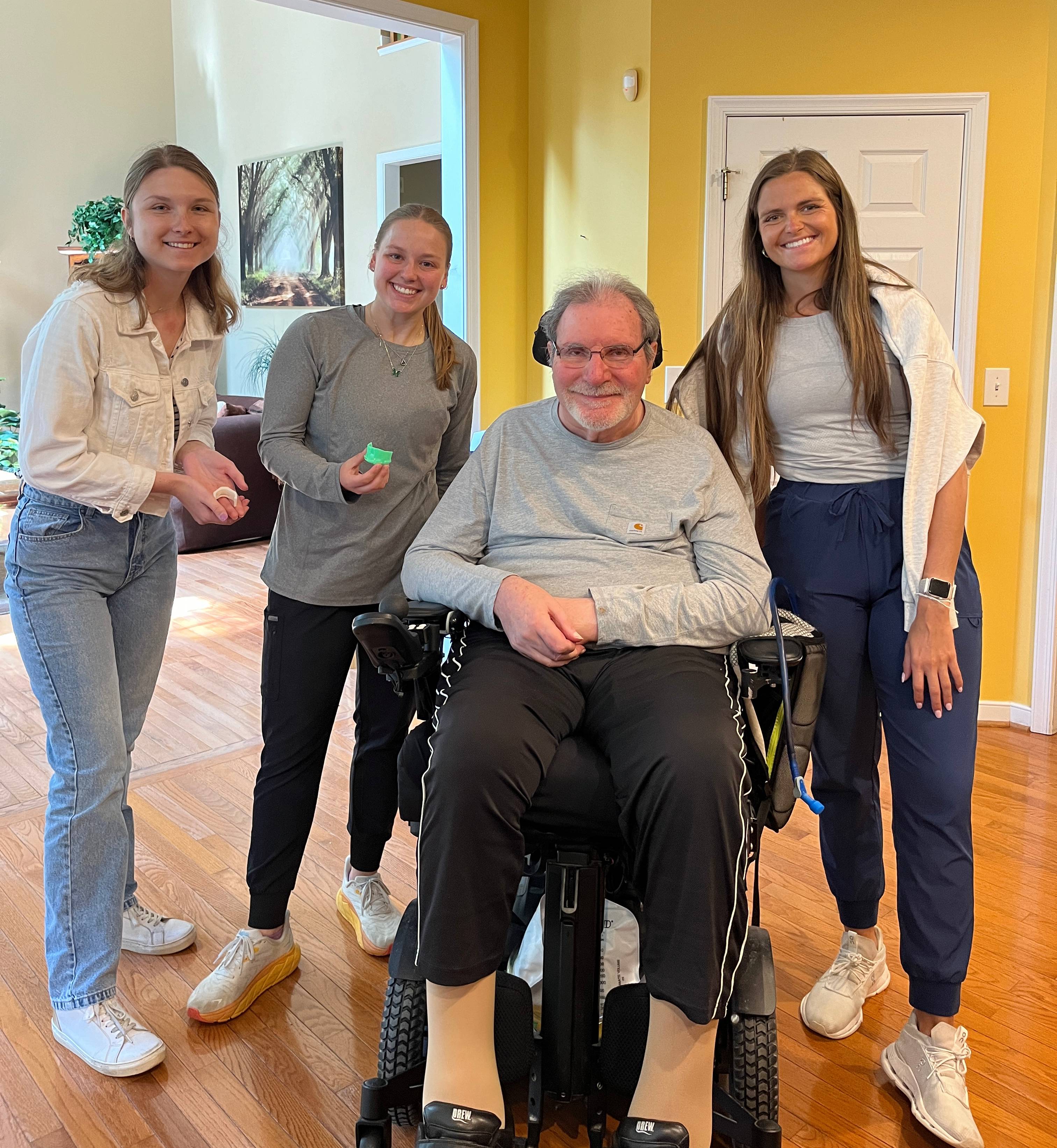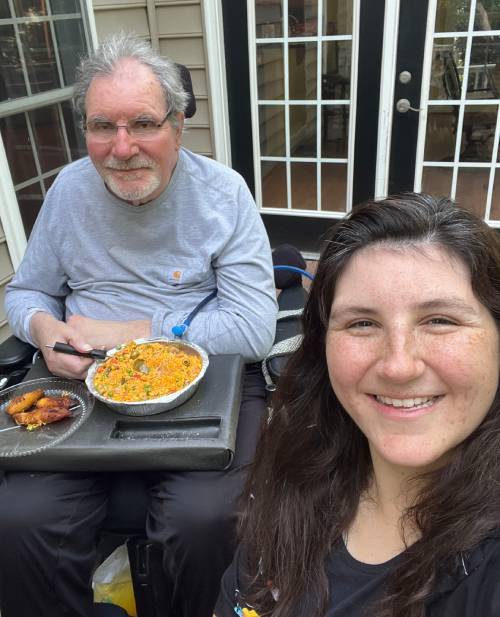A craving for chips and salsa serves up a dose of independence
By Kyra Newman
 Ed Aloma just wanted to enjoy his favorite afternoon treat of chips and salsa solo.
Ed Aloma just wanted to enjoy his favorite afternoon treat of chips and salsa solo.
What got in the way was multiple sclerosis, which has advanced since his 1991 diagnosis and now limits his arm and hand functions. For several years, he’s relied on family members – particularly his daughter, Katie – to feed him every meal.
So Ed brought his snack challenge to students in VCU’s Department of Occupational Therapy, where Katie is pursuing her occupational therapy doctorate.
“I wanted that independence, but I wasn’t thinking of breakfast or dinner,” said Ed, whose disease interrupts the messages his brain sends to tell his body what to do. “I was just thinking of a snack I could have in the afternoon.”
Katie noticed that her dad had started eating apples by himself because he could bring pieces of fruit to his mouth. She could hand him a chip, and he could repeat that motion, “but he couldn’t scoop the salsa onto the chip,” the third-year OT student said.
Last year, Katie completed the course “Occupational Synthesis and Adaptations,” where students kick start their second year with an assignment to solve a unique occupational problem that a real-world client presents. As they start brainstorming possibilities, students also get lessons in basic woodworking, sewing and even 3D printing, which they put to the test as they build prototypes of different designs.
“We have the creative freedom and our imaginations to take the problem and figure out what we can do from there,” said Katie, noting that last year’s class built Ed a tailored lapboard that helps him use his phone and television remote.
When Ed shared the chips-and-salsa challenge, faculty members offered some straightforward guidance: The students wouldn’t be able to modify chips during that course, but they could change the process for how Ed could enjoy those crispy tortilla treats on his own.
Everything starts with the client and challenge

During the course, which expanded from two to three weeks this summer, students start with one-on-one sessions to understand the client’s goals. They visit client homes to understand the environment. They create a prototype to be tested – and repeat that pattern until they find something that works. Three student groups worked on potential solutions for Ed, with one even designing a tool with commercial opportunity.
Early discussions with Ed revealed that he struggled to eat foods — like salsa and oatmeal — because it was tough to get food on the spoon and keep it there on the journey to his mouth. The students looked further to determine what aspects of existing adaptive equipment worked for him.
“We approached our design as the spoon was the issue, and that was what needed to be changed,” said Rachel Davis, a second-year student. Options could be to modify how the spoon functioned or how Ed gripped it, not to mention adapting the bowl that held the salsa. Students spent hours at the Aloma house in Moseley measuring kitchen dishes and assessing the utensils he currently used. They also documented the size of his hands and how far he could extend his arms, all ingredients in delivering a perfect-fit solution.
 Armed with those insights, the student groups dove into brainstorming and rapid prototyping, almost daily delivering a tweaked option for Ed to test. They were encouraged to think about both low- and high-tech alternatives.
Armed with those insights, the student groups dove into brainstorming and rapid prototyping, almost daily delivering a tweaked option for Ed to test. They were encouraged to think about both low- and high-tech alternatives.
“There was lots of trial and error throughout this process,” Davis added, noting her team built food-safe prototypes from resources including thermoplastics, resin and 3D printing material. “Ed was so amazing to work with. We would bring him a prototype, and he would use it and let us know what he thought could make it better for him.”
This experience begins to connect classroom learning with hands-on therapy experiences. “Our students are pulling in knowledge they’ve learned in other courses, such as how different medical conditions impact occupational performance,” said Audrey Kane, Ph.D., OTR/L, assistant professor of occupational therapy. Virginia Chu, Ph.D., OTR/L, and Brooke Dexheimer, Ph.D., OTR/L, joined Kane as course instructors.
“They understand what they need to consider when they’re in an initial evaluation, starting with how a client like Ed feels in doing a specific task,” Kane said. “They need to look at how his body is functioning, from how much movement he has in his arms to how different therapy solutions must be positioned.”
The assignment helped students see “how beautifully fluid OT truly is,” said Karla Estrada, another student in the course. “This project really puts into perspective how each client will be unique in their wants and needs. It’s amazing how OT can push our abilities to best help anyone and everyone.”
Developing and regaining skills
 As they tested out different options, Katie observed that her father began to regain some skills. Those changes are motivating, and he continues to get more mobility as he continues to practice and use skills in daily life. “Seeing that independence bleed into other parts of his life is really cool,” she said. “These are my friends, my colleagues, who are making a powerful difference in the world.”
As they tested out different options, Katie observed that her father began to regain some skills. Those changes are motivating, and he continues to get more mobility as he continues to practice and use skills in daily life. “Seeing that independence bleed into other parts of his life is really cool,” she said. “These are my friends, my colleagues, who are making a powerful difference in the world.”
Watching her dad with occupational therapists over her lifetime gave Katie an early introduction to the field, and she wants to work with pediatric clients after completing her degree. “Being able to see the real-life outcomes of what an OT can do and being on the receiving end – not as a caregiver, but as he daughter who just loves him – makes me be feel like this is the profession for me,” said Katie, who recalled how nice it was to sit outside on Father’s Day and eat with her dad. “I just put the plate in front of him, and that was that. It was just so normal.”
So what was the optimal approach for Ed’s snack challenge? It starts with a slanted bowl, where lightly broken-up chips are sprinkled on top of salsa, and a redesigned utensil that work together to “dam” food onto the spoon.
“And then I’ll just eat it with the spoon, because, yes, it’s too difficult for me to actually dip a chip,” Ed said. “But it tastes the same once you get it in your mouth.”